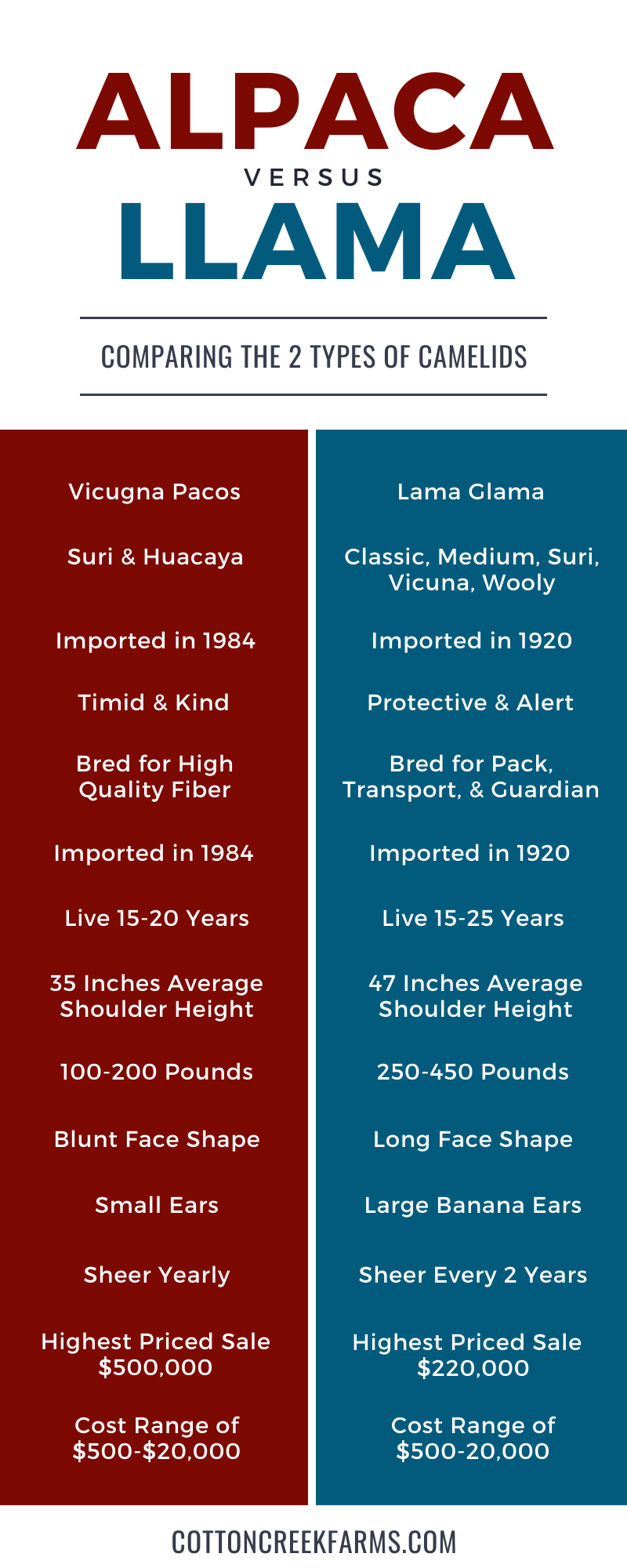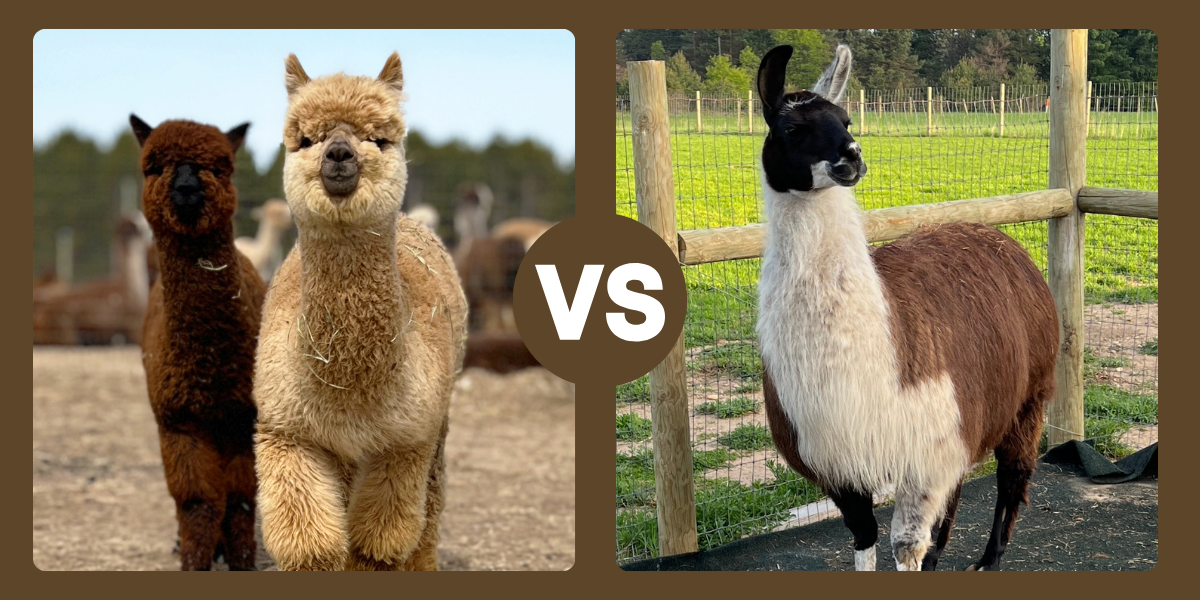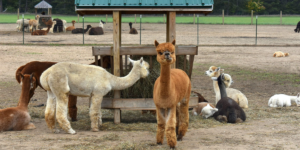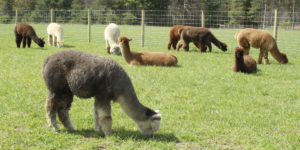We answered the same questions time and time again: what's the difference between an alpaca and a llama. Most people can not tell one from another and many use the terms interchangeably.
You may feel I'm exaggerating, but I am not. We attend the local 4-H fair each year and it has tens of thousands of visitors with record years around 40,000 people. We talk to a lot of those folks and about 95% of them do not know the difference between an alpaca and a llama. Even after pointing out the differences between the two, people were often still confused. The same is true for our farm where we host 5,000+ visitors each year.
And the internet doesn't help this much. There is a lot of misinformation on the web about these animals. I've even found myself contacting the Britannica website to alert them of an error in their content. But when you fall in love with something as deeply as I've fallen for alpacas, it's very easy to get obsessed and to dive into the details.
Examples From Our Farm
In the photo above you see our alpacas Ben and Zack on the left and our llama Lucy on the right. Ben and Zach have smaller ears, they are smaller in overall size, they have smaller noses, and they are softer looking. Lucy the llama is much larger, her fiber looks rougher, and she has much larger features in her nose and ears.
Their personalities are different as well. Lucy llama is more of a protector, where alpacas Ben and Zach are cuddle buddies. Lucy will look at you and question your existence, while the alpaca boys will run over to say hi.
Basic Elements of Alpacas and Llamas
Everywhere I searched online, I found the same generic information about alpacas and llamas. It all focused on size, weight, ears, and faces. Llamas are bigger than alpacas in both height and weight. Llamas have longer faces and larger ears. Llamas were bred as pack animals and alpacas were bred for high quality, luxury fiber.
Yep, this matches up to what we visually see above. But let's go a little bit farther with our information.
Llamas eat more and require more space than their cousin the alpaca. They also mature earlier and they live longer. Llamas are only sheered every other year, whereas an alpaca must be sheered every year.
Alpaca fiber is super fine and luxurious. It is hypoallergenic, water repellant, and it the warmest of wools. It also lends itself to producing high-end fiber products like socks, hats, and throws. Llamas not so much.
Another key point is personality. Llamas are protectors and they are alert. They are pack animals and workers. Alpacas, on the other hand, are more relaxed, and can be just plain goofy.
Overall I'd tell you there are more similarities than differences, but the differences are distinct.
Alpaca and Llamas by the Numbers
Llamas arrived in the United States in 1920, but the alpaca didn't arrive until it was imported in 1984. This makes the United States alpaca industry immature at best. So far I've found a large mixture of pets to show animals and a general sense of separation between the older generation of alpaca farmers and the younger generation arriving now.
Alpacas far out number llamas in the United States. The 2022 USA Census of Agriculture reports 9,774 alpacas to 3,136 llamas. As an alpaca owner, I know those figures do not account for the total population. In fact, they are not even close to accurate.
With alpacas living 15-20 years, we know the census numbers are just plain wrong. The Alpaca Owners Association had 3,679 new alpacas registered in 2024 and the AOA has had 54,809 alpacas registered since 2015. Most of those alpacas born since 2015 would be still living in the US, which tells us the census data is a far cry from the actual alpaca population in the USA. I suspect llamas are the same.
Alpacas tend to also be located in a few key states. Ohio, Washington, Colorado, New York, and California have the largest numbers of registered alpacas. Older information online will state Michigan has a very large population, but this is actually false. Michigan has just over 8,000 registered alpacas which is only about 30% of Ohio's 25,468 alpacas.
Alpaca vs Llama Comparison in Detail
| Characteristic | Alpaca | Llama |
|---|---|---|
| Scientific Name | Vicugna Pacos | Lama Glama |
| Family | Camelidea | Camelidea |
| Class | Mammalia | Mammalia |
| Domesticated | Yes | Yes |
| Types | Suri and Huacaya | Classic, Medium, Suri, Vicuna, Wooly |
| Imported into the United States | 1984 | 1920 |
| Registered Animals in the US | 192,310 | 30,605 |
| Purpose | High Quality Fiber Production | Pack & Transport |
| Livestock Guard Animal | No | Yes |
| Trainable | Yes | Yes |
| Disposition | Timid & Kind | Protective & Alert |
| Required Space | 2-8 Alpacas Per Acre | 3-5 Llamas Per Acre |
| Communal Dung Piles | Yes | Yes |
| Diet | Herbivore | Herbivore |
| Food Consumption | 1-2% of Body Weight Per Day | 2-3% of Body Weight Per Day |
| Life Expectancy | 15-20 Years | 15-25 Years |
| Oldest Known Age | 27 Years | 30 Years |
| Height at Shoulders | 35 Inches | 47 Inches |
| Weight | 100-200 Pounds | 250-450 Pounds |
| Face Shapes | More Blunt | Longer |
| Ears | Small | Larger Banana Ears |
| Fiber is Renewable Source | Yes | Yes |
| Sheering | Every Year | Every Two Years |
| Fiber Quality | Fine & Soft | Course |
| Typical Micron Count of Fiber | 14-40 Microns | 16-70 Microns |
| US Recognized Fiber Colors | 16 | 4 |
| Female Age of Maturity | 18 Months | 12 Months |
| Male Age of Maturity | 2-3 Years | 3 Years |
| Reproduction | Induced Ovulators | Induced Ovulators |
| Pregnancy Testing | Spit Test | Spit Test |
| Gestation Period | 350 Days | 350 Days |
| Birth Weight | 8-23 Pounds | 17-45 Pounds |
| Typical Pricing | $500-$20,000 | $500-$20,000 |
| Highest Known Sale Price | $500,000 | $220,000 |
The Bottom Line
The 4-H fair quickly taught me that alpaca farmers are pro alpaca and llama farmers are pro llama. I don't think I encountered one person who was neutral and/or indifferent.
I'm a 100% alpaca person and I love these sweet, quirky animals more than I can articulate. They are part family, part business, and a focus in my life. I love my llama Lucy, but she just doesn't have the draw that my alpacas do.

References:
The Complete Alpaca Book by Eric Hoffman
alpacainfo.com/about/statistics/alpacas-worldwide
alpacainfo.com/academy/about-alpacas
nelsonroadvet.com/articles/large-animal-exotics/llamas-and-alpacas/
en.wikipedia.org/wiki/Alpaca
en.wikipedia.org/wiki/Llama
lamaregistry.com/registry-services/lama-statistics-owners.php
britannica.com/story/whats-the-difference-between-llamas-and-alpacas
nationalgeographic.com/animals/mammals/l/llama/
nbcnews.com/news/us-news/llamas-disappearing-across-united-states-n994181
nytimes.com/2013/07/04/garden/the-llama-is-in.html
rmla.com/html/education.html





I’m in love with llamas and alpacas. I have almost everything in my room decorated in llamas
I’ve always loved Llamas and considered getting a guard llama and a herd of sheep and then let my husband use the llama for hunting. I’m now considering getting alpaca and starting a small alpaca farm instead. What I’m interested in is whether I could get a llama to protect the alpaca or whether they would get along etc. what are your thoughts?
Llama and alpaca are camelid cousins, so they get along nicely as long as you appropriately match up genders (female with females and male with males). We have a llama named Lucy who lives with our female alpacas and I absolutely adore her. She came unexpectedly from a rescue situation and she has been a very wonderful addition to the farm. She watches over our alpaca herd and while I know she would do her best to protect the ladies, she probably wouldn’t be a formidable match for coyotes, which is our biggest treat. Lucy was escaping her old him often and this is because she lived with a geriatric horse and donkey. When she arrived at our farm, she saw the alpacas, and she was instantly at ease because she knew she was with her “kind” and was in the right place.
Ha! We have a Lama named Lucy too! We used to have two more lamas, they were also named Lucy. One was given away because he was mean and nasty, sadly another died. But they were all named Lucy even the boys. Why? Because we had a cow… named Lucy… and when we would call Lucy the cow to be fed the lamas all came running too. So we figured they must all be named Lucy.
Amazing article! I found so many great words about Alpaca’s and Llama. I’m thinking of getting one and bringing it to my school as show and tell, is there a way i could rent an alpaca or llama for the day and call it he he. Thank you very much.
Mike there are lots of farms that will do on-site visits. Expect to pay for the time at the school and travel with costs ranging from $200-$500.
We used to offer alpacas for weddings, but we’ve stopped doing so. Our alpacas rate leaving the farm and I hate seeing them stressed. But that is our herd. There are many alpacas who truly love adventures and enjoy off-site activities.
We have two acres of lush green grass and a post and rail fence with a single hot wire. What kind of fence is safe for them?
Also, can they stay on the pasture year round or is that dangerous to their health (like foundering in horses etc.)
Penny the best fence is a five foot, no climb metal fence. The hot wire fence is dangerous because they don’t feel it through their fiber until it is too late. It is not recommended for alpacas.
Alpacas happily live in a mix of outside and inside conditions year round. They require shelter, but they do not like to be locked in it. Having a paddock area where they can reside and use either that or their shelter is best for them mentally and physically.
Wow! I learned a lot from your article. I wasn’t entirely clueless about these animals but I’m definitely not savvy. First, I am absolutely shocked that alpacas were not imported until 1984!! I had no idea they haven’t been in the US very long. My perspective is probably influenced because I’m old…ish; I was 22 in 1984 and it seems like yesterday. The second surprise for me was learning that llamas are livestock guardians. Both are very cool animals but after reading your article I’ve fallen in love with alpacas! Wish I could have some for myself.
If you visit the right farm, alpacas will absolutely captivate your heart. With love and the right interactions you will discover alpacas to be sweet, docile, and super entertaining animals. We’ve raised them for years and I still discover something new all the time.